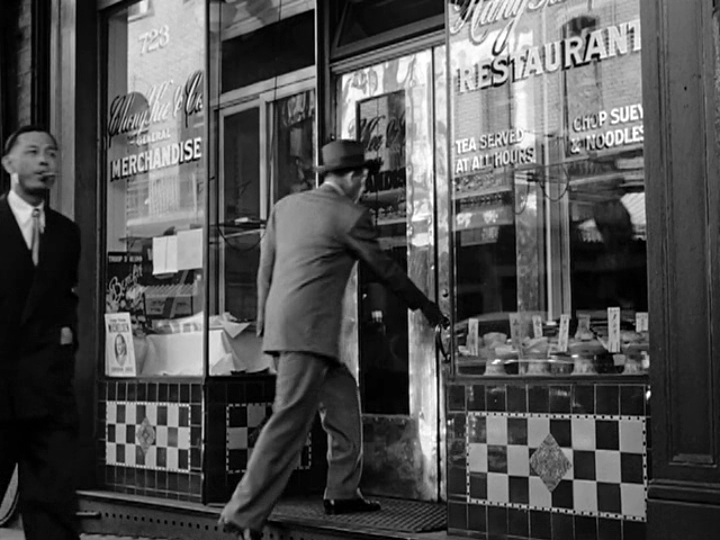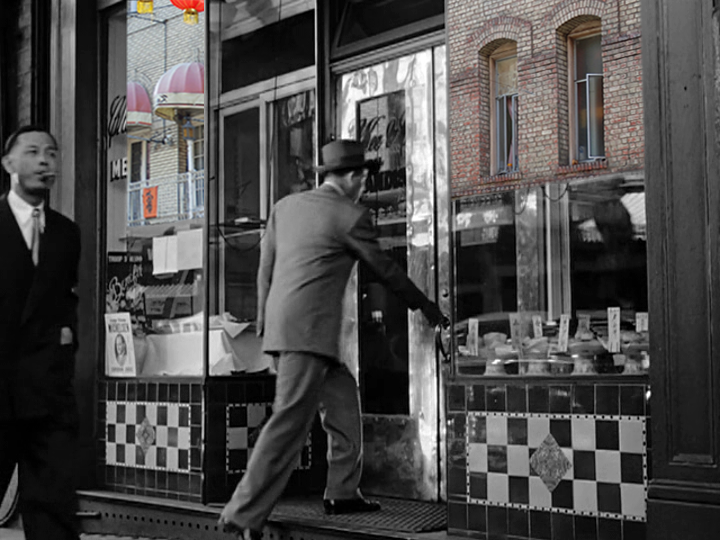Then … Igor Braun, unaware that the FBI have been watching him at work on his latest painting, takes a break for lunch.
… and Now, the previous post identified his address as 1087 Clay Street on the corner of Mason. Today there’s a security gate across the entrance, a sad comment on modern times but at least nicely styled.
Then … From the doorway of the 1055 Mason apartment building where the FBI had set up their stakeout an agent watches the suspect cross Clay Street.
… and Now, there’s now a fire escape on the house across the street, mandated by its added fourth story.
Then … Tailed by the agent, he approaches a crowd congregated around the scene of an accident.
… and Now, this is the junction of Sacramento Street and Grant Avenue in Chinatown; the brickwork of the business at far right is now covered by colorful painted murals. On a historical note, Grant Avenue’s ornately distinctive lampposts were installed in time for visitors attending the 1939 Golden Gate International Exhibition.
Then … Viewed across Grant from the reverse direction, Braun pushes his way through the crowd. The building at the top of Sacramento is the Brocklebank Apartments (famously the home of Madeleine Elster in Vertigo). Both the Brocklebank and the Western Union Telegraph Office on the corner at 669 Grant would appear one year later in scenes from the movie Impact. Note the Chronicle in the newsstand trumpeting victories by the Bay Area’s baseball teams, the San Francisco Seals and the Oakland Oaks.
… and Now, believe it or not, it is still possible to send a telegram (over the web, not via Western Union) but this Telegraph Office closed decades ago: its space is now part of the adjacent business, the China Bazaar at 667 Grant Avenue. (By the way, in 1929, more than 200 million telegrams were sent but by 2005 the number was down to 21,000).
Then … Braun crosses the road then turns right, along the 600 block of Grant. There are lots of eateries to choose from here, including the Far East Cafe seen across the street.
… and Now, 72 years later, the Far East, at 631 Grant, is still there. It dates back to 1920 so it will celebrate its centennial this year; how many restaurants in San Francisco can make that claim? But as we will see, Igor Braun has a different place in mind.
Then … This shot of him entering a restaurant offers two clues as to its location - the address number 723 next door and the window reflections of the buildings across the street. This is the famous Hang Far Low restaurant (a name that provoked many a smirk over the years) at 725 Grant (map). You can just make out - on the window at upper right - part of the decoratively written Hang Far Low. Click or tap the image to see how the gallery and windows of the buildings opposite 725 Grant today would match those 1948 reflections.
The restaurant’s menu, as did the window above, advertised Chop Suey & Noodles.
Then … Hang Far Low restaurant is no longer in business but it too had a long history. It opened in the 1880s, was destroyed in the 1906 earthquake fire, then reopened in 1907 on the top two floors of the building depicted in the vintage postcard below. The arrow points to the same street-level entrance seen forty years later in the Then image above. By 1960 Hang Far Low had closed, succeeded by the Four Seas restaurant.
… and Now, the Four Seas too was destined to have a long run, finally closing in 2013. Its entrance had been moved to the right below the awning. Today the upstairs restaurant tradition carries on with the Michelin-starred Mr. Jiu’s, now accessed from the rear of the building at 28 Waverly Place. A clothing store specializing in kimonos currently occupies the ground level.
… a vintage photo … this c. 1950 photo shows the Western Union office and the 700 block of Grant Avenue as the moviemakers experienced them; the arrow points to the Hang Far Low entrance. Note its vertical sign ‘Noodles, Hang Far Low’. Note too the ‘Kimonos Pajamas’ sign close by; they too had an extended Chinatown presence.
Then … Malatesta drives Joe to his home at the end of a cul-de-sac in the Telegraph Hill neighborhood.
… and Now, This is the section of Montgomery Street that is punctuated by the Montgomery Steps (map), a drastic but effective solution to what would otherwise have been a dangerously steep block. Comparing Then and Now, Telegraph Hill has remained relatively unscathed compared to the Financial District straight ahead.
Then … Malatesta’s house is at 1227 Montgomery at the top of the Montgomery Steps.
… in 1951 … here’s another look at the house, in the background 6 years earlier in a scene from The House On Telegraph Hill.
… and Now, the home has since gained a garage in front plus an added third story. (On a trivia note, the same house was extensively featured inside and out as Donald Sutherland’s character’s place in the 1978 movie Invasion Of The Body Snatchers: see it here).
Then … They enter the property through a side gate at the top of the steps.
… and Now, the front of 1227 Montgomery has since been enclosed, replacing the gate with a more substantial entrance.
Tony Curtis was captured in this candid shot at the top of the steps during a relaxing cigarette break during the shooting of this scene.
Incidentally, the 1952 movie The Sniper showed a victim, viewed here from the lower level, being stalked down the Montgomery Steps.
Inside the home Malatesta introduces Joe to his cousin Anna (Marisa Pavan). She abruptly stops mid-sentence and it’s clear from her expression that she’s been hit by what Italians call Colpo Di Fulmine, ‘The Thunderbolt’, aka love at first sight. (Hmm, it’s also clear that the Production Code censors overlooked the no-bra look).
Then … The interior scenes in the Malatesta home were filmed on a studio set but for this garden shot a photo backdrop showing San Francisco Bay in the distance off to the left was included to imply its location.
… a vintage photo … but that photo wasn’t taken from 1227 Montgomery … instead, it’s from the Mark Hopkins Hotel in Nob Hill. Here’s the same view in a 1961 photograph, this one taken from the Top O’ The Mark whereas parallax differences indicate that that the movie photo was taken from a lower level in the hotel. The dominant white building is the U.S. Appraisers building at 630 Sansome Street and above that are Yerba Buena Island, Treasure Island and the cities and hills of the East Bay. (Image by Getty Images)
… and Now, this recent photo taken from the Top O’ The Mark again shows just how much the Financial District has grown over the last half century. The U.S. Appraisers building is still there, hidden by the newer buildings. (Image by Carol M. Highsmith)
Then … Our stern narrator informs us that the subject of the painting was the view from the rear of Igor Braun’s third floor studio apartment in this building.
… and Now, the building today is just as it was more than 70 years ago; it’s in Nob Hill on the southeast corner of Clay and Mason Streets; Braun’s apartment number is 1087 Clay (map). (But, as CitySleuth pointed out earlier, the painting actually depicted buildings on Market Street, miles from here).
Then … The FBI agents decide to set up an observation post in the 3rd floor corner apartment above Bedayan’s grocery store at 1101 Clay. Visible along Clay Street are traces of the torn-up cable car tracks of the Sacramento-Clay Street line that had closed down six years earlier, in 1942.
… and Now, No more groceries here, 1101 Clay currently houses an upscale furniture and lighting business. (Trivia time - the corresponding corner, at 1153 Taylor just one block up the hill from here, is where Steve McQueen’s apartment was in Bullitt).
Then … Agents O’Hara and Grayson walk past the grocery up Mason from Clay, heading to their observation room set up in the uppermost protruding bay window seen above them.
… and Now, isn’t it good to see a part of town mostly unchanged after close to three-quarters of a century?
Then … This is the same shot viewed from behind showing them approaching 1055 Mason Street, on the right below the awning, where their observation room is. On the left at the top of the hill are the Fairmont and the Mark Hopkins hotels, two of the City’s icons, then, as now.
… and Now, this recent wide angle view along Mason shows where the stakeout and the staked-out were.
From the corner window O’Hara looks across to Igor Braun’s studio.
From here they spy on him as he works on a new painting.
Then … Joe has quit the force and is free to conduct his own personal investigation. He heads to Malatesta’s seafood restaurant at Fisherman’s Wharf to check him out. When this location scene was filmed this was Andy’s Look Out, a 6-stool coffee shop serving breakfast and burgers to local fishermen.
… and Now, In 1965 brothers Al and Joe Scoma bought the restaurant, renaming it Scoma’s. Over the decades they have expanded it into today’s landmark eatery, seen here. In fact, Scoma’s became so popular that the city renamed the 2900 block of Jones Street that leads to it (formerly informally aka Jones Alley), as ‘Al Scoma Way’ (map).
The 1957 street directory of the 2900 block of Jones confirms the restaurant name as Andy’s Look Out.
Then … Inside the restaurant Joe strikes up a conversation with Malatesta who doesn’t flinch when Father Tomasino’s name is brought up.
… and Now, The window view today reflects building changes across Jefferson Street. In both images Coit Tower is seen in the background.
Then … Joe mentions that he is looking for work and Malatesta follows him when he leaves.
… and Now, this space is now a kitchen area for Scoma’s.
Insisting that “Any friend of Father Tomasino is a friend of mine”, Malatesta generously invites Joe to his home for dinner, telling him he might be able to give him a job.


